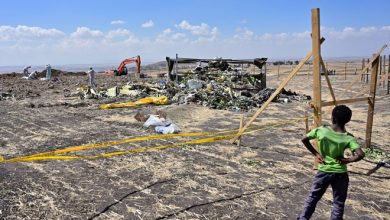Coronavirus Threatens To Double World Hunger; UN Warns Of ‘Biblical’ Famines
COVID-19 is spreading through East Africa. Since its first detection on 13 March in Kenya and Ethiopia, countries in the region have increased their testing capacities, the number of COVID-19 cases have risen steadily in the region, now reaching more than 2,000 cases and 28 deaths. COVID-19 strikes at a time when the region is fighting an ongoing desert locust outbreak and is recovering from drought and floods in 2019.
COVID-19 is spreading through East Africa. Since its first detection on 13 March in Kenya and Ethiopia, countries in the region have increased their testing capacities, the number of COVID-19 cases have risen steadily in the region, now reaching more than 2,000 cases and 28 deaths. COVID-19 strikes at a time when the region is fighting an ongoing desert locust outbreak and is recovering from drought and floods in 2019.
• The triple threat of COVID-19, floods and locusts is a major concern in East Africa and in the coming weeks. According to FEWSNET, locust breeding and formation of new swarms has been reported in Somalia, Kenya and Ethiopia, and mature swarms have arrived in Southeastern cropping areas of South Sudan and are spreading in areas of Karamoja sub-region in Uganda. The start of the long rains is sustaining conducive conditions for breeding which is likely to result in formation of new swarms by June-July. Heavy rains and floods have also begun in Kenya and are expected elsewhere in the region in the weeks ahead. Food insecurity is already alarmingly high in East Africa.
• WFP estimates that 20 million people are food insecure in nine East African countries: Ethiopia, South Sudan, Kenya, Somalia, Uganda, Rwanda, Burundi, Djibouti and Eritrea. Home to only 3 percent of the world’s population, the region also hosts 22 percent of the world’s total number of acutely food-insecure people.
• WFP expects humanitarian needs to increase in the coming months as the crisis escalates. Stress on the weak health systems in the countries will persist, the fragile political environment and insecurity will exacerbate the already highly vulnerable countries like South Sudan, Burundi, and Somalia.
The socio-economic fallout from the pandemic will be far more devastating than the disease itself.
• In 2019, WFP alone assisted nearly 24 million people in the East Africa. WFP estimates that the number of food insecure people in the region is likely to increase from 20 to 34-43 million in the next three months due to effects of COVID-19. This 43 million total would include a total of 20 million people in IPC Phase 3 food insecurity and above, nearly 17 million urban poor and 3.2 million refugees who depend on assistance
• Of particular concern is the urban population, in which hundreds of thousands of people employed in the informal sector have already lost their sources of income, threatening their food and livelihood security. The refugee population is also at risk, a possible outbreak in the refugee population would put more pressure on the heath system and potential protections risk could emerge.
• Meeting the food security needs of populations in urban slums across the region is a critical enabling factor to contribute to prospects for stability and security in this tumultuous period. While the urban populations are already affected with a significant reduction in economic activities, for households in the rural areas, it is very important to watch how this pandemic affects the farming activities in the approaching main cropping season, and its impact on the livestock sector.
• The governments in the region continue to enhance preventive and control measures to slow the contagion. A key priority to mitigate food insecurity in East Africa is to keep borders open. A protectionist response would have disastrous effects. WFP commends Governments in East Africa for cooperating to keep food flowing so people dependent on markets can still access the right food at the right time.





